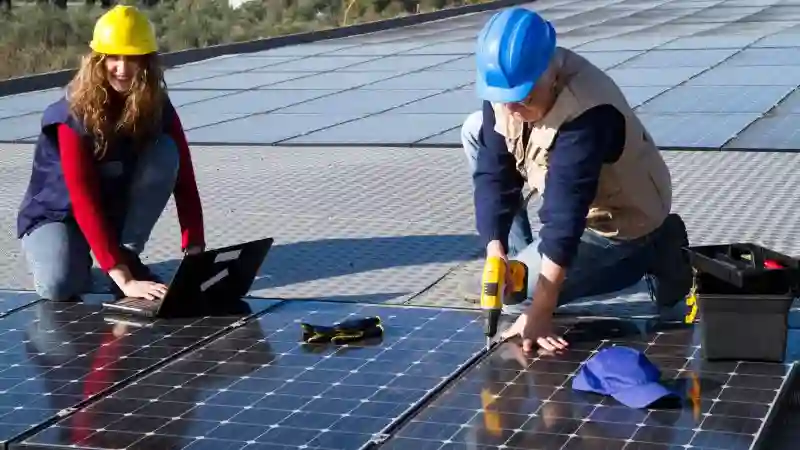Solar panels have gained widespread popularity as a clean and renewable energy source, harnessing sunlight to generate electricity. While solar power systems are often associated with sunny and warm regions, they can be highly effective in cold climates as well. However, cold climates present unique challenges for solar panel installations. In this comprehensive guide, we’ll explore the challenges of using solar panels in cold climates and the solutions to maximize their efficiency and performance.
The Challenges of Cold Climates
Cold climates, characterized by harsh winters and low temperatures, can pose several challenges to solar panel installations:
1. Reduced Sunlight Hours
In cold climates, especially during the winter months, there are fewer daylight hours and less direct sunlight available. This can result in lower energy production compared to sunnier regions.
2. Snow Accumulation
Snow accumulation on solar panels can obstruct sunlight, reducing energy production. Additionally, heavy snow loads can potentially damage the panels and mounting structures if not properly managed.
3. Low Temperature Effects
Cold temperatures can affect the efficiency of solar panels. Solar cells typically perform better at moderate temperatures, so extremely cold conditions can lead to reduced energy output.
4. Ice Formation
Ice formation on the surface of solar panels can further reduce their efficiency. Ice can block sunlight and cause structural damage if not addressed promptly.
5. System Freezing
Extreme cold can lead to freezing of the components within the solar power system, including batteries and inverters, potentially causing operational issues.
Solutions for Maximizing Solar Panel Efficiency in Cold Climates
Despite these challenges, solar panel installations in cold climates can still be highly effective when the right solutions are implemented. Here are several strategies to maximize the efficiency and performance of solar panels in cold regions:
1. Proper Tilt and Orientation
Optimizing the tilt and orientation of solar panels is crucial in cold climates. Tilt angles can be adjusted to capture more sunlight during the winter months when the sun is lower in the sky. Panels should also be oriented to face south in the Northern Hemisphere and north in the Southern Hemisphere for maximum exposure to sunlight.
2. Snow Removal
Regular snow removal from solar panels can significantly improve energy production during the winter. Gentle brushing or using specialized snow removal tools can help prevent snow accumulation from blocking sunlight.
3. Anti-Icing Coatings
Applying anti-icing coatings or materials to the surface of solar panels can prevent the formation of ice and reduce the impact of freezing temperatures.
4. Tracking Systems
Solar tracking systems can be used to follow the sun’s path throughout the day, optimizing the angle of the panels for maximum exposure to sunlight. While these systems are more complex and expensive, they can significantly increase energy production in cold climates.
5. Ground-Mounted Arrays
Ground-mounted solar panel arrays can be raised off the ground to reduce the risk of snow accumulation. Additionally, ground-mounted systems allow for easier access for snow removal and maintenance.
6. Battery Storage
Installing a battery storage system can help store excess energy generated during sunny periods for use during cloudy or nighttime conditions. This ensures a continuous power supply even when energy production is limited.
7. Insulation and Heating
Solar panels can benefit from insulation and heating systems that help prevent snow and ice buildup. These systems can be automated to activate when needed.
8. Quality Panels and Components
Investing in high-quality solar panels, inverters, and other components can improve the overall performance and longevity of the solar power system, even in cold climates.
9. Monitoring and Maintenance
Regular monitoring and maintenance are essential to identify and address issues promptly. This includes checking for snow accumulation, ensuring all components are functioning correctly, and cleaning the panels as needed.
10. Financial Incentives
Many regions with cold climates offer financial incentives and rebates for solar panel installations. These incentives can help offset the initial costs of the system and improve the return on investment.
Benefits of Solar Panels in Cold Climates
Despite the challenges, there are several benefits to using solar panels in cold climates:
1. Energy Savings
Solar panels can significantly reduce electricity bills, which can be high in cold climates due to heating and lighting needs. Solar energy can help offset these costs.
2. Environmental Impact
Solar power is a clean and renewable energy source that reduces greenhouse gas emissions and environmental impact, contributing to a more sustainable future.
3. Energy Independence
By generating their electricity, homeowners and businesses in cold climates can become less reliant on traditional energy sources, increasing energy independence.
4. Longevity
Solar panels are built to last, with lifespans exceeding 25 years. Properly maintained systems can continue to provide energy even in harsh cold climates.
5. Energy Storage
Battery storage systems can provide a reliable source of energy during periods of limited sunlight, ensuring a consistent power supply.
Conclusion
Solar panels can be highly effective in cold climates, providing a clean and sustainable source of energy. While challenges such as reduced sunlight hours, snow accumulation, and low temperatures exist, they can be overcome with proper design, maintenance, and the right solutions. Maximize the efficiency of your solar panel installation by optimizing tilt and orientation, implementing snow removal strategies, and considering advanced features like solar tracking systems and battery storage. With the right approach, solar panels can thrive even in the harshest of cold climates, offering numerous benefits to homeowners, businesses, and the environment.



